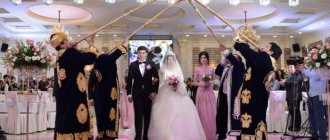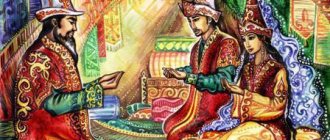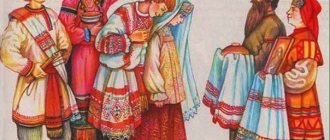Armenian wedding... What could be more beautiful and larger-scale than this great holiday, filled with positive emotions, fun and many national rituals and customs? For a long time, Armenians have sacredly respected their traditions and sincerely believe that their observance brings happiness and prosperity to the newly born family.
A lot of people are always invited to the celebration: from the closest to the most distant relatives. You will be welcome, even if you barely know the bride and groom. Those who have at least once had the opportunity to attend an “Armenian wedding” will no doubt agree that they have never seen a more fun and memorable wedding. Armenians are friendly and peace-loving people who have great respect for the process of creating a family and having children.
How does matchmaking and engagement work?
Among Armenians, the right to choose a bride belongs to the groom’s parents, or more precisely, to his mother. The woman is very enthusiastic about finding a suitable match for her son, taking into account not only the girl’s background, but also her health, hard work and education. There are no special requirements for external evaluation criteria.
Next, the groom’s mother negotiated her choice with her husband, after which a mediator was selected among close relatives. Her goal was to negotiate over the young man's intentions to marry the girl. If a positive response was received from the bride's mother, the matchmaking could take place.
The Armenian wedding ceremony begins with matchmaking, which is attended exclusively by men. They discuss the purpose of their visit with the bride’s relatives and ask for approval for their children’s marriage. But according to tradition, the first time a positive answer from the girl’s parents could not be given. This meant that a second visit could not be avoided.
After successful matchmaking comes an equally important part of preparing for the wedding - engagement.
The expected engagement day is agreed upon in advance. Many relatives gather at the groom's house, bringing with them various gifts for the young bride.
First, the feast is held at the groom's place, and a rich festive table is laid out. Later, the same event takes place in the bride’s house, with the same characters.
A respected relative (kavor) from the groom’s side takes the bride and her bridesmaids out and places them at the groom’s table. A young girl accepts gifts from guests. After this, the newly minted groom puts a wedding ring on his beloved’s finger. The engagement is accompanied by songs, dances and fun competitions.
After the entertainment part of the holiday has come to an end, the kavor and the groom's father decide on what day the wedding celebration will take place.
“I was riding a bike and lost my virginity.”
Some girls who have had premarital sex, in order not to “disgrace their family,” decide to undergo hymenoplasty (surgery to restore the hymen). In Armenia, this operation can cost from 100 to 400 dollars.
Gynecologist Elena Gevorkova does not perform this operation herself, based on personal principles: “This is not a disease. I take it as a whim."
However, there are many such requests, says Gevorkova. According to her, nine out of ten girls who come to her tell the same story: “Basically it’s a fairy tale about a girl riding a bike as a child, falling and losing her virginity, and now she has to get married. And this is how she will now prove her innocence. Well, people don’t ride bicycles in such numbers in our country.”
About a third of the girls who decide to undergo such an operation come alone, says Gevorkova. About a third come with their mother.
“This decision is made jointly: the girl plus the parents, so that later we don’t hear complaints from the husband like: “Well, I took the girl from you there, but she’s not crystal.” This moment is especially unpleasant for me because it smacks of pimping. If I understand that this is not only “wishing well” for the girl, but also an attempt not to provoke anger on myself, saying that I failed to raise a worthy Armenian, then for me this is an even more deformed relationship.”
However, the doctor continues, there were also cases when a girl came for help, accompanied by her boyfriend.
“This happens after the future husband understands that his mother is quite conservative about the “red apple” tradition and, in principle, there is a chance that the newlyweds’ bed will be examined the next morning. In order not to upset their mother, the guys decide to take such a step,” says Elena Gevorkova.
Wedding preparations
The traditions and customs of the Armenian people require a number of mandatory events to be held before celebrating a wedding.
The first obligatory ritual is the bride's viewing.
It is held with the purpose that the newlyweds have the opportunity to see each other before the wedding. To do this, the future groom and his close relative make a visit to the bride’s house, while treating the girl’s mother or sisters to sweets. Every other day, sweets are distributed to neighboring children.
To ensure that the celebration takes place in an organized manner, a ritual called “kyasum trel” is performed. During it, the groom and the groom's father negotiate all the expenses for the holiday, the number of people, the menu, etc. Next comes the stage of active preparation, which includes, first of all, an agreement on the date of the wedding in the church.
Issues regarding the number of guests are also discussed. The venue for the celebration is selected and the wedding program is drawn up.
Red Apple
Among the many ancient customs that the Armenian people honor is the “red apple”. It is worth noting that this ritual evokes controversial feelings, however, this tradition is still relevant to this day in many Armenian families. The essence of the ritual is that after the first wedding night they bring a red apple, symbolizing the innocence and purity of the bride. Modern young people do not want to demonstrate their personal lives and do not welcome this tradition, considering it a relic of the past.
In the old days, such a ritual had practical significance - the groom and his relatives had confirmation that before the wedding there were no other men in the girl’s life and, accordingly, the father of the child was the young husband. However, it is worth noting that this ritual gained popularity during the Soviet Union. Today, such a custom is a confirmation of the fact that before the wedding the bride was chaste and did not have sexual intercourse with other young people.
Carrying out an Armenian wedding
In Armenia, a wedding without a wedding is not recognized, so this ceremony is mandatory for a young couple. It is very important that no one passes between the newlyweds during the process.
Considering that there are a lot of people, this is watched by young people from the groom’s side – the Kavors.
During the wedding, one of the Cavors must hold a crossed sword and scabbard over the heads of the couple. This ritual is associated with the fact that metal protects the couple from evil spirits. It is worth mentioning another important and quite interesting ritual.
During the ceremony, the priest tied special cords on both the bride and groom's hands (sometimes necks), the ends of which were covered with wax. This cord has a name - narot. No one except a clergyman can remove it independently. This action did not allow the spouses to have close relationships; they had to wait until the cord was untied. After the main event, the wedding, comes the official part of the celebration - the wedding.
This event requires the newlyweds and their relatives to observe a huge number of rituals that help the couple to be happy in marriage.
The wedding took place in two houses, and it began in the morning. In the groom's house, a bull was traditionally slaughtered, whose neck was decorated with apples. During this action, young girls sang songs and danced.
And at this time the groom had to make an incision on the bull’s neck with a knife, and then put the knife in his pocket.
The kavor smeared the groom's forehead with fresh blood. The boy's mother had to take a thread and soak it in this blood. The thread was kept until the wedding night.
Armenians associate such an unusual ritual with childbirth, since the bull itself serves as a symbol of fertility. The newlyweds are greeted by their mother-in-law in the house of their future spouse. She gives the bride and groom a spoonful of honey and places lavash on their shoulders. When the newlyweds enter the house, they are sprinkled with raisins and flowers from baskets. This custom gives young people a prosperous and peaceful life.
In the bride's house there is a big feast, toasts are made, and music is played.
But the musical accompaniment has a sad motive, since the girl’s parents are saddened that their now adult daughter is leaving her home. At the end of the feast, the bride and groom dance. At the end of the dance, the girl’s father joins the hands of the young couple and blesses the couple.
After this, everyone returns to the groom’s house, where most of the entire celebration in honor of the birth of a young family takes place. The bride's brother tries to prevent the couple from leaving the house, thereby protesting and wanting the sister to stay in this house.
Cavor comes to an agreement with his brother and gives him a bride price. It is impossible to say unequivocally that the wedding traditions of the people belong only to Armenians, because their festive rituals are mixed with the rituals of other peoples. It is worth noting that the Armenian feast began with toasts, which honored the memory of deceased relatives. After this, it was only possible to congratulate the newlyweds and make toasts in their honor.
According to old customs, the bride was not given a place at the table; she stood in the corner behind a beautiful curtain, surrounded by a large number of amulets and amulets.
Now, of course, the wedding takes place in a more civilized manner, and the bride sits at the wedding table next to her newly-made husband.
The holiday was accompanied by cheerful songs and dances. During the celebration, the guests presented the newlyweds with gifts and money.
The guests who represented the groom's side had fun from the heart, thereby expressing their joy that their groom had found such a wonderful bride. The bride's relatives were more reserved because they were sad and sad that the bride was leaving her father's house. Modern Armenian traditions are no longer much different from those to which we are accustomed. But still, some rituals were preserved and passed on from generation to generation.
An experienced toastmaster who is well versed in national traditions is invited to the celebration.
Details
The first wedding night is spent on the groom's territory
, in his house. After the newlyweds retire to a separate room, they can be considered husband and wife. In the old days, there had to be a person under the door of the newlyweds' room, who subsequently informed the groom's parents about the girl's innocence.
Usually this role was performed by the cook or the bride's friend. After receiving the news, the friends of the young spouse fired into the air, notifying everyone of the result of the wedding night.
Before her wedding night, according to tradition, an Armenian bride must hug several men from among the groom's relatives. By hugging little boys (and hugs with them should be done first), the bride could count on many children born in this marriage.
Who cares about a red apple?
Armenian society has always taken women's chastity very seriously. The bride must be pure in body; virginity is her main trump card, even more important than beauty, economic skills and education, not to mention the size of the dowry. Perhaps this is why the custom of giving red apples to the bride's parents was invented. The morning after the wedding, the husband's relatives who came to the house must make sure of the integrity of the newlywed. The matrons examine the bed in which the newlyweds spent their first night. Sometimes approval is taken out of the house: a sheet with traces of lost virginity is hung on the street so that everyone knows: the guy took the right girl as his wife. Having congratulated the newlywed, the husband's relatives send her mother red apples and a bottle of red wine or cognac, tied with a red ribbon, as a sign of gratitude for the proper upbringing of her daughter. It is clear that today this custom is found only in the remote villages of Shirak - perhaps the most strict region of Armenia. In modern Yerevan and almost all other cities of the country, parents, and especially other relatives, do not interfere in the relations of the young, but they keep the habit of giving apples to in-laws. But even this offends militant - uh - feminists (?) and girls who prefer... girls.











